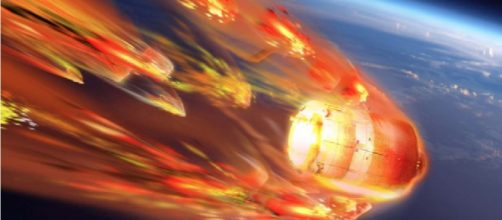The Chinese space station Tiangong-1 is on its way down to the Earth’s surface after plummeting from orbit, and experts are saying that it could crash in a big fireball at some point during this coming Easter weekend – some say as early as Saturday. One of the nicknames of the space station is “Heavenly Palace,” which is ironic, since it’s now a ball of flames hurtling rapidly towards the Earth, so perhaps “Hellish Palace” would be a more apt name for it.
Tiangong-1 is one of the biggest space projects ever launched by China. The space station is 40 feet long and it’s expected to re-enter the Earth’s atmosphere over the next couple of days.
That’s according to the European Space Agency, who have been following this space station crash closely since it started to fall from the sky. Their current guess is that it will land between the 31st of March and the 1st of April, while the China Manned Space Engineering Office are estimating it a bit later, at either the 1st of April and the 2nd of April.
The earliest estimates were placing the crash-landing of Tiangong-1 as late as the 4th of April. But are we going to get hit by debris? A whole space station is falling from the sky – what are the chances that a little bit of debris will hit one of seven billion people who populate the Earth in the head? Well, it’s not all that likely, scientists are saying.
Since the space station is expected to burn up as it re-enters the atmosphere, the odds of getting hit by falling debris are one in one trillion, so don’t worry.
The odds of getting hit by falling debris are one in a trillion, scientists claim
The China Manned Space Engineering Office published a report via the media outlets owned and operated by the Chinese government to assure people that there is “no need” to panic about the debris that will fall when the Tiangong-1 space station returns to Earth. They put an end to the fears of any “sci-fi movie scenarios” like “Armageddon” or “Deep Impact,” by which there would be a huge, explosive, deadly collision with the Earth. Apparently, it will “look more like a shower of meteors” than a Hollywood science fiction blockbuster disaster movie.
So, in other words, China say relax (that’s a t-shirt reference). Tiangong-1 was launched back in 2011 as a forerunner to the permanent space station that the country’s leaders want to have up there in outer space by about 2022. The one that is now hurtling towards the Earth was more or less just a prototype for that one. The Chinese government announced to the UN last May that the Tiangong-1 space lab had “ceased functioning” way back in March 2016, but they didn’t elaborate on how or why it had stopped functioning.
Tiangong-2 has already been launched
Tiangong-2, the latest prototype of China’s planned permanent space station – kind of like the sequel to this one that’s now crashing down back into our atmosphere – has already been launched.
It was sent into orbit successfully back in September 2016, so this was all going on before China had even told anyone that the first one had stopped working. The sequel, if you will, was launched into orbit from a Chinese launch centre in the Gobi Desert.
As for the crashing of Tiangong-1, it won’t be anything too spectacular, but if you’re lucky enough to bear witness to it, scientists say that you may see a “series of fireballs” when it comes down to the Earth’s surface. According to Markus Dolensky, who is the technical director at the International Center for Radio Astronomy Research in Australia, witnesses will only get to see these “fireballs” shooting across the sky if there are no pesky clouds in the way.

